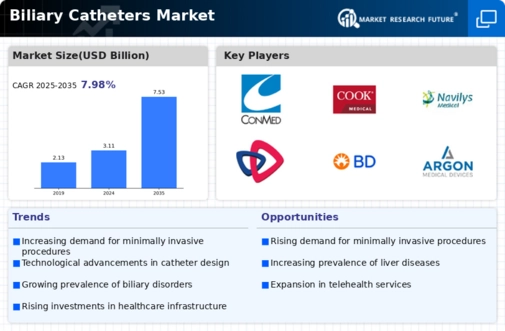Biliary Catheters Size
Biliary Catheters Market Growth Projections and Opportunities
The market for biliary catheters is significantly influenced by the rising incidence of biliary diseases such as gallstones, infections, and cancers. As the prevalence of these conditions increases globally, the demand for biliary catheters for diagnostic and therapeutic purposes sees a parallel rise. The aging population due to demographic shift spurs the growth of the market biliary catheters. Whether biliary disorders, it is at older persons who are more vulnerable and some interventions like biliary catheterization has to be done as a result of biliary tract disorders. Continual innovations in catheter technologies lead the market. Material, design, and manufacturing process innovations lead to a more effective and also more convenient for patients biliary catheters which leads not only clinical outcomes but also to the market competition. Trend toward minimally invasive procedures inclusive of endoscopic and percutaneous interventions affects market of biliary catheters. As other diseases of liver and pancreas described as cirrhosis, and pancreatitis also contribute to the demand for biliary catheters. Such catheters are widely used for drainage, stenting and decompression in obstructive patients thus effecting the market structure. The growing demand for combination catheters capable of fulfilling several purposes creates an effect on the market. The all-purpose combination biliary catheters, boasting features such as drainage and irrigation functions, offer holistic remedies, fulfilling the ever-changing demands of medical practitioners. The growth of the market partly influences the healthcare infrastructure, especially in the emerging markets. Better access to healthcare facilities aid in early diagnoses and treatment of biliary disorders resulting to the increased need for biliary catheters. More importantly, public awareness campaigns and screening programs for biliary disorders affect change in market trends. Increased understanding of the symptoms and risk factors of biliary diseases leads to early diagnosis and intervention which in turn affects the total demand for biliary catheters. Significant roles have biliary catheters reimbursement policies and economic considerations in the Biliary catheters market. Favorable (more positive than negative—favorable—beneficial) reimbursement scenarios can encourage adoption of biliary catheterization procedures by healthcare providers, while economic limitations can present some hurdles to market growth. The globalization of healthcare and medical device markets affects the accessibility of biliary catheters. Manufacturers must navigate regulatory variations and market access challenges in different regions, impacting the distribution and adoption of biliary catheters globally.












Leave a Comment